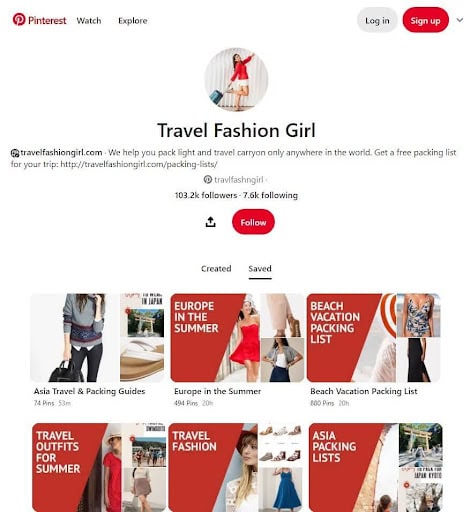
Pinterest has emerged as a formidable player in the digital marketing arena, particularly for visual-based content. Unlike other social media platforms, Pinterest operates more like a search engine, where users actively seek inspiration, ideas, and products. With over 450 million active monthly users, Pinterest is a goldmine for marketers looking to tap into an audience that is already primed for discovery and purchase.
Statistics underscore Pinterest’s significant impact on purchasing decisions. According to recent Pinterest data, 80% of U.S. users utilize Pinterest for purchase inspiration. This makes Pinterest an indispensable tool for marketers aiming to influence buying behavior directly.
The Basics of Affiliate Marketing on Pinterest
Affiliate marketing involves promoting products or services through unique affiliate links, earning a commission for each sale made via those links. On Pinterest, this process is seamlessly integrated through pins and boards.
Marketers create visually appealing pins that link directly to affiliate products. When users click on these pins, they are redirected to the affiliate’s website, where any resulting purchase earns the marketer a commission.
Pinterest supports this model by allowing clickable links within pins, making it easier for marketers to drive traffic to their affiliate partners. The visual nature of Pinterest helps showcase products effectively, making it an ideal platform to earn in affiliate marketing.
A recent study showed that over four out of five Pinterest users buy something after seeing brand content, highlighting its potential for driving sales through affiliate marketing. By leveraging Pinterest’s visual appeal and large user base, marketers can effectively promote products and earn commissions.
How to Leverage Pinterest for Affiliate Marketing Success<
1. Setting Up Your Pinterest Account for Business
To maximize the potential of affiliate marketing on Pinterest, starting with a business account is crucial. Here’s how to set it up:
Convert or Start a Business Account: If you already have a personal Pinterest account, you can convert it to a business account. Alternatively, you can create a new business account from scratch. This can be done through the account settings on the Pinterest website.
Complete Your Profile: Ensure your profile has a professional profile picture, a compelling bio, and a link to your website or blog.
Enable Analytics and Ads: A business account grants access to Pinterest Analytics and advertising options essential for tracking performance and reaching a broader audience.
2. Choosing the Right Affiliate Programs
Selecting the right affiliate programs is pivotal to your success on Pinterest. Here are some tips:
Resonate with Pinterest Demographics: Pinterest’s user base skews towards women, with significant interest in niches like home decor, fashion, beauty, and DIY. Choose affiliate programs that align with these interests for better engagement.
High-Quality Products: Promote visually appealing products with a strong reputation. Successful products often include those that people are proud to pin and share.
Examples of Successful Products: Items like stylish home decor, trendy clothing, beauty products, and innovative DIY tools have seen great success on Pinterest.
3. Creating Effective Pinterest Content
Creating compelling content is the heart of successful affiliate marketing on Pinterest. Here are some best practices:
Designing Attractive Pins: Use high-resolution images and eye-catching designs. Tools like Canva or Adobe Spark can help create professional-looking pins without advanced design skills.
Compelling Pin Descriptions: Write descriptions that are both informative and engaging. Use keywords strategically to enhance discoverability through Pinterest’s search functionality.
Tools for Creating and Scheduling Pins: Utilize tools like Tailwind or Hootsuite to schedule your pins for optimal times, ensuring consistent posting and greater reach.
4. Strategies for Growing Your Pinterest Presence
Building a substantial following on Pinterest requires a strategic approach:
Increase Followers and Engagement: Engage with your audience by responding to comments, repinning others’ content, and joining group boards relevant to your niche.
Pinterest SEO: Optimize your profile, boards, and pins with relevant keywords. Use Pinterest’s search bar to find trending keywords and incorporate them naturally into your content.
Consistent Pinning: Regularly pin new content to keep your profile active and engaging. Aim for at least 5-10 pins per day to maintain visibility.
5. Using Analytics to Track and Improve Performance
Analytics are vital for measuring the success of your efforts and making data-driven adjustments:
Pinterest Analytics Overview: Use Pinterest Analytics to track key metrics like impressions, saves, clicks, and overall engagement. Identify which pins perform best and understand what resonates with your audience.
Third-Party Tools: Tools like Google Analytics can offer deeper insights into traffic and conversions driven by Pinterest. Tailwind also provides comprehensive analytics tailored to Pinterest.
Adjusting Strategies: Based on your analytics, tweak your content strategy. Focus on high-performing pins, refine your targeting, and continuously test new ideas. Don’t forget to promote your affiliate marketing programs continually.
Case Studies and Success Stories>

Examining successful Pinterest affiliate campaigns can provide valuable insights. Here are three notable examples:
Travel Fashion Girl
Alex Jimenez, the founder of Travel Fashion Girl, successfully used Pinterest to promote her affiliate links for travel-related products. By creating visually appealing packing lists and travel outfit ideas, she was able to engage her audience effectively. Her pins are linked directly to products on her affiliate partners’ websites, such as Amazon and other travel gear retailers.
Alex’s strategy included using rich pins and detailed descriptions to increase the visibility of her content on Pinterest. This approach significantly boosted her traffic and affiliate income, making her a prominent example of successful Pinterest affiliate marketing.
Grace & Lace
Clothing brand Grace & Lace leveraged Pinterest to grow their affiliate sales by creating boards featuring their latest collections and styling tips. They collaborated with fashion influencers who pinned photos wearing their clothes, linking back to the product pages.
This strategy increased brand visibility and drove significant traffic to their website. Combining influencer partnerships and Pinterest’s visual platform helped Grace & Lace achieve high conversion rates, demonstrating the effectiveness of targeted affiliate marketing on Pinterest.
Pinch of Yum
Lindsay Ostrom, the creator of the food blog Pinch of Yum, used Pinterest to share recipes that included affiliate links to kitchen gadgets and ingredients. Her high-quality food photography and easy-to-follow recipes attracted a large following.
Incorporating affiliate links into her pins and blog posts allowed Lindsay to drive substantial traffic to her affiliate partners. This strategy increased affiliate earnings and showcased the potential for monetizing content through Pinterest’s platform.
University of Michigan
To stay relevant and attract prospective students, universities are increasingly turning to social media for innovative marketing strategies. Leveraging platforms like Pinterest can help institutions highlight their unique offerings while engaging with future students.
The University of Michigan, for example, used Pinterest to market the university and engage with prospective students. They created boards showcasing campus life, alumni profiles, study tips, and online MSW programs. Additionally, they shared infographics with tips for freshmen and recommendations for healthy and easy recipes.
Highlighting affordable online MSW programs for 2024 on such platforms can draw attention from students looking for cost-effective education options while also showcasing the flexibility of online learning. This strategy enables institutions to effectively target and appeal to a diverse pool of prospective students.
Lessons Learned
These examples highlight the importance of high-quality visuals, strategic collaborations, and understanding audience preferences. Consistent engagement, the strategic use of keywords, and leveraging Pinterest’s unique features, such as rich pins, are crucial for maximizing the impact of affiliate marketing campaigns.
With over $3 billion in revenue in 2023, Pinterest is a proven performer in the social media landscape. This stability makes it a solid platform for your affiliate marketing strategy. By learning from these successful campaigns, marketers can enhance their strategies and achieve significant results on Pinterest.
Conclusion: Maximizing Your Pinterest Affiliate Marketing Strategy
To stay ahead in the competitive world of Pinterest affiliate marketing, consider these final tips:
Stay Updated with Trends: Pinterest is dynamic, with trends constantly evolving. Keep an eye on emerging trends and adapt your strategy accordingly.
Engage Continually: Maintain an active presence by regularly posting and interacting with your followers. Engagement fosters loyalty and can lead to higher conversion rates.
Utilize Resources and Tools: Leverage available resources and tools to streamline your efforts. Platforms like Tailwind, Canva, and Pinterest’s analytics can significantly enhance your efficiency and effectiveness.
Pinterest affiliate marketing offers immense potential for profitability when approached strategically. By understanding the platform, creating compelling content, and continuously optimizing your strategy based on data insights, you can pin your way to success.

